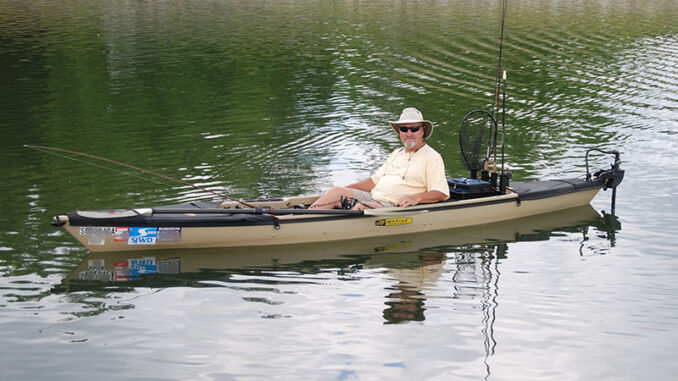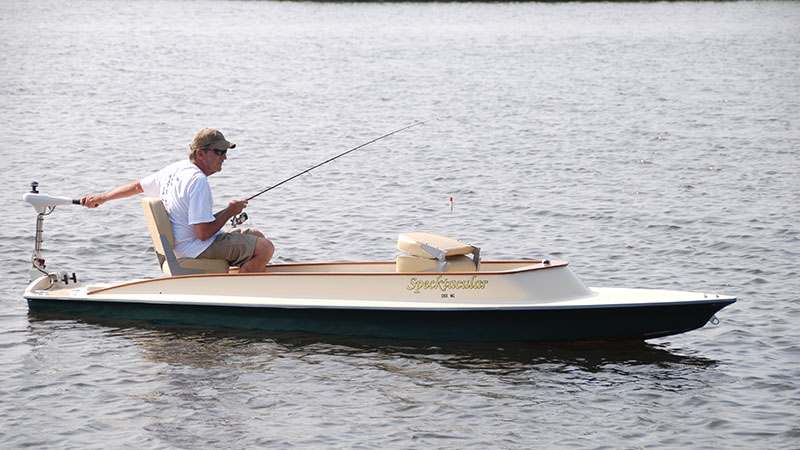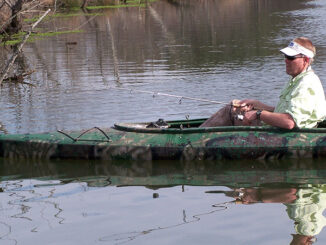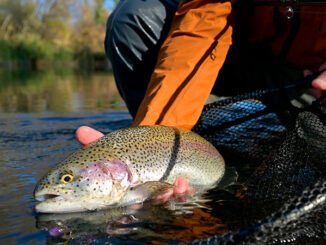
Adding a motor on a kayak is not a new concept. It’s safe to say kayak anglers have had options to add motors for at least the past 20 years.
But, what’s so great about having a motor on a kayak? Here’s a few of the positive takeaways.
More range. Modern kayak motor manufactures are bragging about 60+ mile range on one charge with some of their newest models.
It’s easier. Older anglers or those with injuries or disabilities see a kayak motor as a doorway to continue enjoying the sport beyond their physical limitations.
Defeat the wind and current. Today’s electric motors can automatically lock you into position using internal compass and GPS coordinates. Imagine holding your position in a 10-mph wind or steady current by simply depressing a button. Other features include the ability to reposition the boat in any direction by 10 to 15 feet with the push of another button.
Less fatigue, more enjoyment. Kayak anglers looking for a relaxing day on the water catching fish would probably agree that less fatigue equals more enjoyment.
Most of the controversy surrounding kayak motors comes up in tournament competition. When angling for money, all of the participants strive for an even playing field. It’s not a stretch to say that motorized kayaks are an advantage for some or all the reasons cited above.
Some years ago when foot pedal kayaks were emerging, the pedalers were thought to have the advantage over the paddlers because leg propulsion allowed you to be hands-free to fish. This advantage is compounded with motorized propulsion being both relatively hands-free and less fatiguing.
Another drawback to motorized kayak angling is the weight of the motor and battery or power supply. In a boat where weight management is precious, having a motor is a big consideration. The rigging and mounting of the motor can throw the kayak off balance or make the boat tippy.
Finally there’s the cost. A ready-made kayak trolling motor and kit can be costly. Doing it all yourself will cut the price in half.
The add-ons include a lightweight 12-volt battery, maybe some controls, and a bracket that will fit somewhere on the kayak.
Are kayak motors here to stay? Probably, but time and popular opinion will decide if dropping the paddle in favor of the tiller is the next evolution in the kayak angling world.
The hybrid
Bill Bannister from the northern Outer Banks Area of North Carolina may not exactly be a kayaking enthusiast, but he did see the benefits of having a small, maneuverable, shallow draft boat that he could launch into the back bays of Pamlico Sound to chase his favorite fish – speckled trout.

Bannister’s boat, dubbed the Specktacular, is a fiberglass model complete with teak trim, spacious in-deck hatches, and two pedestal seats, all the power boat amenities you miss in a kayak.
The narrow shallow draft and overall size of the craft give it a kayak-feel. The boat can slip quietly into backwaters without spooking fish. And maneuvering and positioning the boat are similar as well.
Bannister powers the boat with a 12-volt electric trolling motor, a saltwater, tiller steer model that clamps onto a molded transom built onto the boat for this purpose. He steers from the rear of the boat and often fishes from the same seat, although a forward pedestal seat is also available.
Due to the weight of the craft, Bannister has a small, kayak-sized trailer that he uses to get the boat to the water. Like a lot of kayak anglers, the weight and the trailer don’t allow him to use the popular throw-in areas that are available, so he must launch the craft from a typical boat ramp.
Best Bets
NORTH CAROLINA
WHAT — Striped bass
WHERE — Coastal rivers, inland lakes
HOW — Look for birds working baitfish on the surface, then cast live bait or topwater lures or shallow-running jerkbaits. White, pearl, and natural colors will work.
LAUNCH — www.ncwildlife.org/boating/where-to-boat/
INSIDER TIP — Schooling stripers are fun to catch, but usually on the smaller size. Target bigger stripers by fishing deeper and off to the side of the surface schoolers.
SOUTH CAROLINA
WHAT — Redfish
WHERE — Charleston area marsh flats
HOW — Spot and stalk schools of redfish. Get ahead of these schools, then cast shrimp- or minnow-imitating lures with embedded scent in the plastic.
LAUNCH — www2.dnr.sc.gov/managedlands/boatramp/boatrampsearch
INSIDER TIP — Public access is limited here, but many marsh areas and bays have dirt ramps perfect for launching kayaks.





Be the first to comment